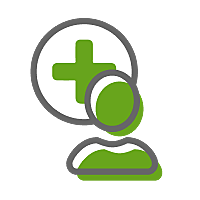Chlamydia and Gonorrhoea Test Kit
If you need to take a chlamydia and gonorrhoea test, you can order a chlamydia and gonorrhoea home test kit through our online doctor service.










-
If you think you have chlamydia or gonorrhoea, you can order a chlamydia and gonorrhoea test kit through our website. For men, you will need to do a urine (pee) sample. For women, you will need to take a vaginal swab. You can get your results within 3 to 7 days.
To order your chlamydia and gonorrhoea test kit through our website, select ‘Get started’. You will need to complete a brief medical questionnaire. Your chlamydia and gonorrhoea test kit will then be sent to your address in discreet packaging. You can get tested without needing to wait for an appointment or leave your home.



-
-
Chlamydia and gonorrhoea test kits can check for the 2 most common STIs in the UK, which are chlamydia and gonorrhoea. With a test kit, you can check at home if you have chlamydia or gonorrhoea, by taking a swab or urine sample. If you think you are at risk of an STI, have had unprotected sex, or have a new sexual partner, you should order a chlamydia and gonorrhoea test.
-
-
You should be regularly tested for STIs if you have a new sexual partner or have unprotected sex. It is common for chlamydia to have no symptoms and almost 50% of infected women do not know they have gonorrhoea. This increases the chances of passing an STI on without knowing. Both chlamydia and gonorrhoea can cause further health concerns if left untreated.
-
-
The easiest way to take a chlamydia and gonorrhoea test is by ordering one online, through our website. You can also get tested at a local sexual health centre or your GP. Some pharmacies offer chlamydia testing.
When taking a chlamydia and gonorrhoea home test, follow the instructions in the pack. Women will need to do an internal vaginal swab as urine testing is not as accurate in women. Men will need to take a urine sample. You should catch the first half of your urine flow. Do not forget to label your samples correctly, as this is how your results will be processed in the laboratory.
-
-
A chlamydia and gonorrhoea test will take about 10 minutes if you are doing it yourself. This is how long it will take to collect the swabs, fill out your sample bottles, and package the test up. You can then send it to the lab.
If you get a chlamydia and gonorrhoea test at your GP or sexual health clinic, you might have to wait to get tested, unless you have an appointment. Most sexual health clinics offer a walk in service.
-
-
You should get tested for chlamydia and gonorrhoea if you have:
- symptoms of chlamydia or gonorrhoea
- been told by a sexual partner to get tested because they have tested positive
- had unprotected sex with a new sexual partner
If you do not have symptoms, you should wait 2 weeks after sexual activity to get a chlamydia and gonorrhoea test. Your results might not be accurate if you get tested too soon.
Chlamydia is more common in those under 25 years old and gonorrhoea is common in anyone who is sexually active, especially if you did not use a condom or other barrier contraception. It is recommended to get tested at least once a year if you are under 25 and sexually active.
-
-
When you have finished your home test, send it to the laboratory as soon as you can. Once the laboratory has received your sample, they will test it and send the results to our doctors. Your test results will be made available on your online account within 2 to 3 days.
-
-
Your test result will tell you whether you have tested positive or negative for chlamydia and gonorrhoea. A positive result means that you have the infection and need treatment. Our doctors will tell you what to do next.
If you get a negative result, this means you did not have the infection when you took the test. If you get symptoms or still think you have an STI, speak to your doctor. They might recommend taking another test.
-
-
If you test negative for chlamydia and gonorrhoea, you do not need to do anything. If you test positive, you need to get the right treatment. Your doctor will give you support and advice on getting treatment. You also need to speak to any sexual partners, as they need to get tested.
-
-
Taking a test at home has been found to be just as accurate as getting a test at your GP or sexual health clinic, according to this study. Accuracy is improved when you take the test correctly, so make sure to follow the instructions carefully.
You can always ask one of our doctors if you are unsure. You also need to wait 2 weeks after having sexual activity when taking a chlamydia and gonorrhoea test.
-
-
Chlamydia is a very common STI in the UK, especially in those under 25. It is often symptomless, which makes it easier to pass on unless you get tested regularly. Chlamydia is caused by a bacteria which can be spread through sex, as well as through contact with infected vaginal fluid or semen.
-
-
Most of the time, chlamydia does not cause any symptoms. If you do get symptoms, you might get:
- unusual discharge from your genitals or bottom
- in men, pain and swelling in your testicles
- pain when urinating (peeing)
- in women, pain in your stomach, bleeding between periods, and bleeding after sex
-
-
Gonorrhoea is a common STI that is caused by a bacteria called Neisseria gonorrhoeae. The bacteria usually lives in discharge and can be passed through sex or through contact with infected vaginal fluid or semen.
-
-
The main symptoms of gonorrhoea are:
- thick yellow or green discharge from your penis or vagina
- in women, bleeding between periods
- pain when urinating
Around 1 in 10 men and half of all women do not get any symptoms at all.
-
-
Gonorrhoea is usually treated with antibiotics, which can kill the source of the infection. This is commonly an injection in the thigh or buttocks or a tablet. Usually, more tests will be done to confirm which antibiotic is best for your infection, because there are high rates of resistance which means that some antibiotics might not work for you. If you have symptoms, they should go away within a few days. Chlamydia is treated with an antibiotic called doxycycline, which is taken for a week.
If you still have symptoms after your treatment is finished, speak to your doctor. If left untreated, chlamydia and gonorrhoea can both cause complications. It can also be passed onto your unborn baby. If you are pregnant, speak to your doctor straight away.

Dr Kathryn Basford is a qualified GP who works as a GP in London, as well as with ZAVA. She graduated from the University of Manchester and completed her GP training through Whipps Cross Hospital in London.
Meet our doctorsArticle created: 28 Feb 2022
Last reviewed: 28 Feb 2022
-
Chlamydia (2021) NHS (accessed 20 February 2022)
-
Gonorrhoea (2021) NHS (accessed 20 February 2022)
-
How long should I wait before I test? (2020) Oxford University Hospitals NHS Foundation Trust (accessed 20 February 2022)
-
Sexually transmitted infections (STIs) (2021) NHS (accessed 20 February 2022)
-
Swab-yourself Trial With Economic Monitoring and Testing for Infections Collectively (SYSTEMATIC): Part 1. A Diagnostic Accuracy and Cost-effectiveness Study Comparing Clinician-taken vs Self-taken Rectal and Pharyngeal Samples for the Diagnosis of Gonorrhea and Chlamydia (2021) Oxford University Press (accessed 20 February 2022)


GMC: 7074021

GMC: 6149061

GMC: 7085115







